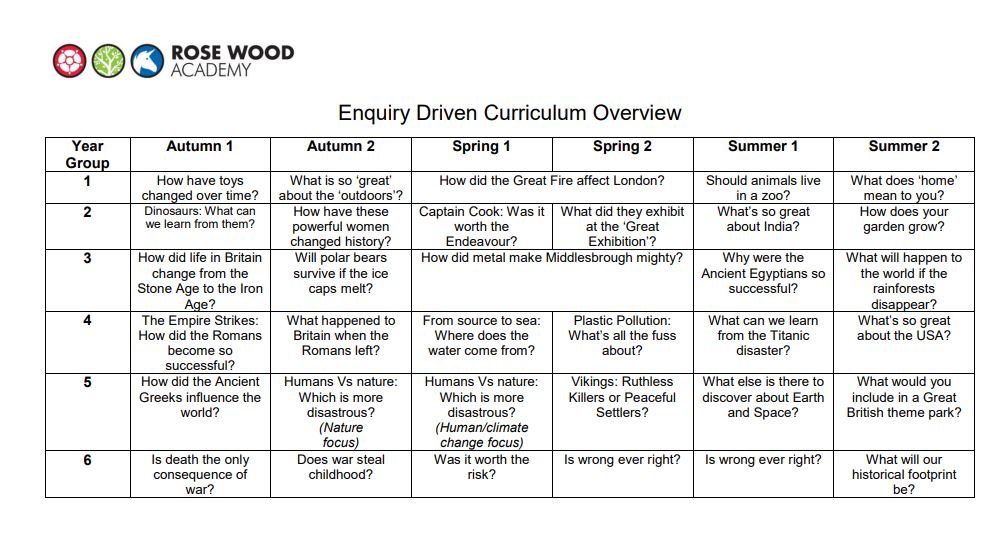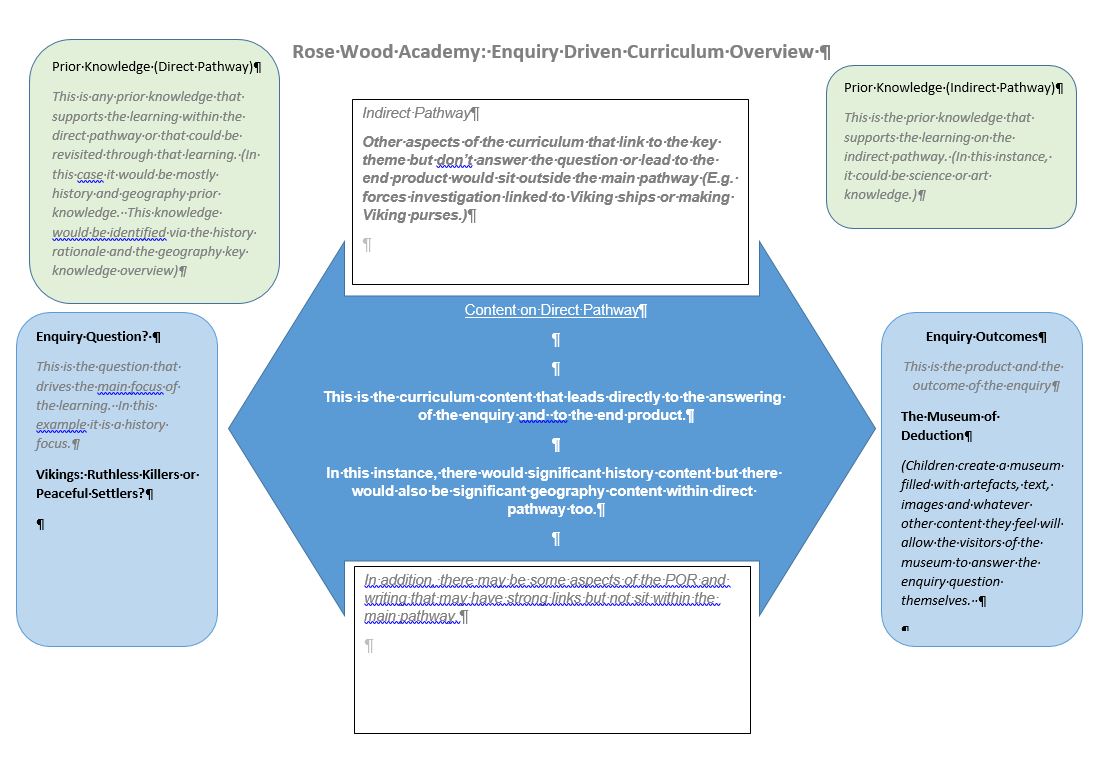Enquiry Driven Curriculum
Curriculum Overview
Approach
The wider curriculum at Rose Wood is delivered through an enquiry driven approach. This approach is underpinned by our teaching and learning principles as outlined in the ‘Teaching and Learning’ document. The enquiry driven curriculum is designed to be cross-curricular and is underpinned by quality literature. The curriculum is designed to engage and enthral with aspects that are practical and academic and prepare children for the next stage of their life and education.
What do we mean by Enquiry Driven?
Each unit of study is driven by an enquiry in the form of a question. This question is the main driver for the core content of the unit. For example, science may be the main focus of a unit of work. In this instance, the question is a science driven one such as ‘How does your garden grow?’ or ‘What else is there to discover about Earth and space?’ When geography is the main focus of study, the questions are geography driven, such as ‘From source to sea: where does the water come from?’ or ‘What would you include in a Great British theme park?’ In the case of history being the key focus, the questions are history driven such as ‘Vikings: Ruthless Killers or Peaceful Settlers?’ or ‘The Empire Strikes: How did the Romans become so successful?’ The main focus of the study is what we call the ‘direct pathway’ and this direct pathway contains the study that will allow the children to answer the question.
Curriculum Content
Direct Pathway
As described above, the key focus of an enquiry will be subject specific but there are always obvious cross-curricular links that are needed as part of an enquiry. For example, in order to understand the history of the Vikings and their reasons for invasion and settlement, it is important to understand the geography of Scandinavia and the UK. To understand more about the impact and long term change caused by the Great Fire of London, children need to understand the historical layout of London and the influence the fire had on the modern layout. Any subjects that contribute to directly answering the enquiry question are built into the learning and form the content of the direct pathway. This cross-curricular approach allows us to revisit content but also allows for the teaching of new content with context.
Indirect Pathway
Not all curriculum content is covered on the direct pathway even though there are good curricular links, such as the study of mosaics when learning about the Romans. Although this is a cross-curricular link it does not sit within the direct pathway as it does not directly answer the question. It does, however, complement the learning and supports with context. This is our complementary or indirect pathway. Subjects such as art, DT and music are often the ones that complement the learning but do not sit on the direct pathway. This is not always the case however and any subject can be part of the direct pathway or linked to it.
Underpinned by Literature
We have adopted the ‘Power of Reading’ approach as a school. We value great literature and know its importance, especially when linked to the wider curriculum learning. For this reason, each of the EDC units is underpinned by a quality text. For example, the book ’Shackleton’s Journey’ by William Grill underpins the Year Six EDC unit that has the enquiry question ‘Was it worth the risk?’ Content from the book, alongside a historical study of events at the time and a study of the geography of the Antarctic, drive learning. These sit within the direct pathway. Some work associated with the books may be strongly linked and are identified in our EDC planning but sit outside of the direct pathway. For example, the book ‘Arthur and the Golden Rope’ supports the children’s learning about Vikings but does not directly answer the enquiry question. This approach means we give real purpose for our reading and create significant content for the children to include in their writing, as well as developing a love of literature. Children are able to produce lots of content which enables the staff to focus on developing their technical skill.
The Importance of Prior Learning
As outlined within the ‘Teaching and Learning’ document, we know the importance of building on prior knowledge as well as revisiting prior knowledge to deepen understanding and retention. The way this is done for each subject is outlined within the individual subject statements. In our EDC, we identify the specific prior learning when we plan. This ensures that we build on it and revisit it.
The Enquiry Outcomes
The enquiry outcomes are a vital part of the learning process. They are the end product and, as well as answering the enquiry question, must have significant content and be something that allows the children to share their learning with others. This could be in the form of an exhibition to parents, other pupils in the school or even the public. It could be a book or online publication. It could be an art installation or a movie etc. This gives real purpose and meaning to the learning and creates a sense of achievement and pride.
Discrete Content
Some subjects do not fit within an EDC, either on the direct or indirect pathway. These subjects are still taught but they are taught discretely. Some subjects such as maths and PE are often, but not always, standalone. Any subject can be standalone, however, as we know there is no benefit to tenuous curricular links.
The diagram below shows the key aspects of our Enquiry Driven Curriculum with some examples of the type of content that may be included. This diagram is used to support the planning of our EDC and is used in conjunction with the curriculum content that is outlined in each of the subject statements.

